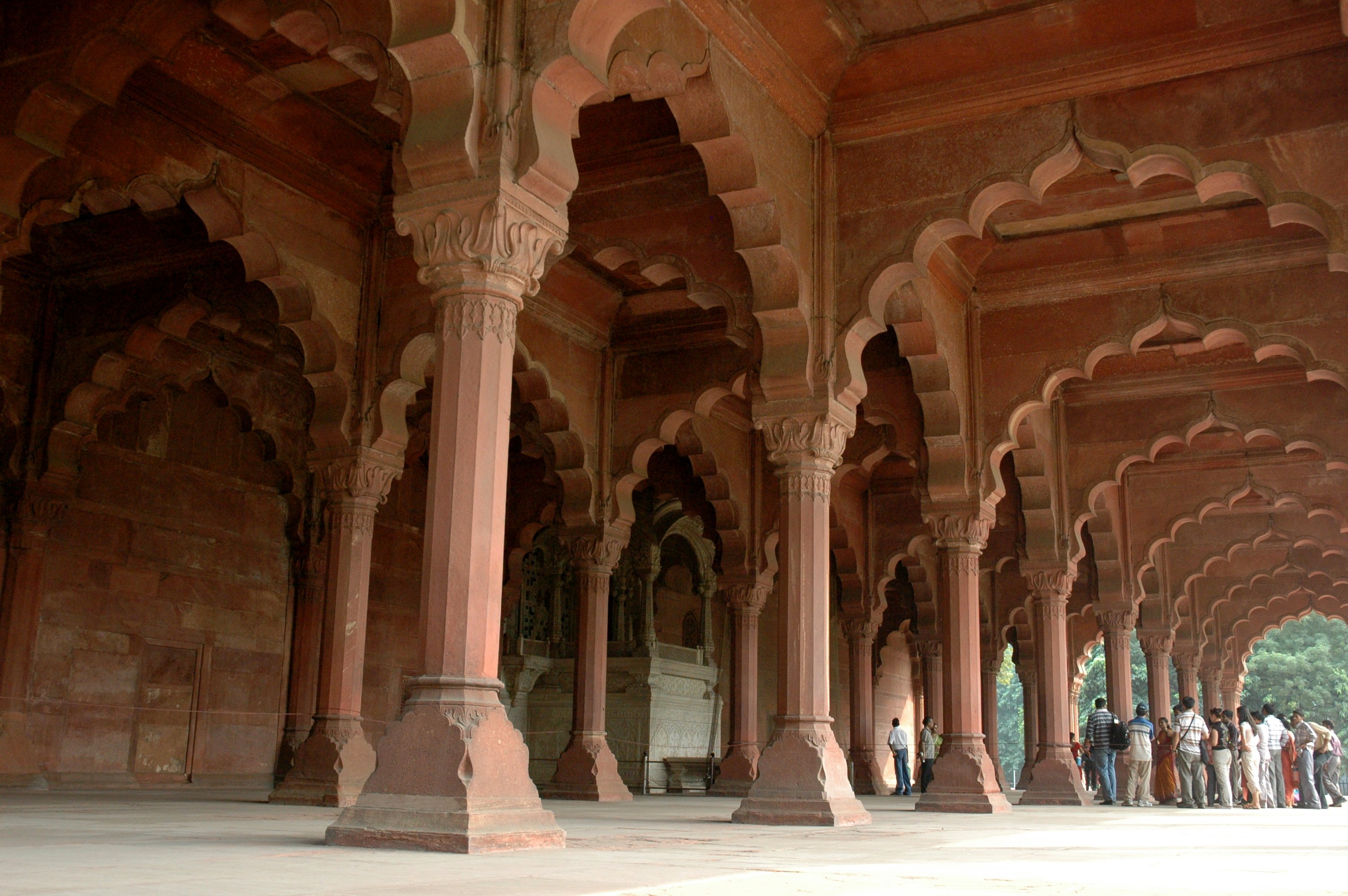Diwan-i-Aam (Red Fort, Delhi) on:
[Wikipedia]
[Google]
[Amazon]

 The ''Diwan-i-Am'', or Hall of Audience, is a building in the
The ''Diwan-i-Am'', or Hall of Audience, is a building in the
File:Ghulam Ali Khan 009b.jpg, The wall of the balcony with inlay work (painting by Ghulam Ali Khan, before 1854)
File:Royal Platform with Marble Canopy - Diwan-i-Am - Red Fort - Delhi 2014-05-13 3213.JPG, The throne of
Red Fort
The Red Fort, also known as Lal Qila () is a historic Mughal Empire, Mughal fort in Delhi, India, that served as the primary residence of the Mughal emperors. Emperor Shah Jahan commissioned the construction of the Red Fort on 12 May 1639, fo ...
of Delhi where the Mughal emperor
The emperors of the Mughal Empire, who were all members of the Timurid dynasty (House of Babur), ruled the empire from its inception on 21 April 1526 to its dissolution on 21 September 1857. They were supreme monarchs of the Mughal Empire in ...
Shah Jahan
Shah Jahan I, (Shahab-ud-Din Muhammad Khurram; 5 January 1592 – 22 January 1666), also called Shah Jahan the Magnificent, was the Emperor of Hindustan from 1628 until his deposition in 1658. As the fifth Mughal emperor, his reign marked the ...
(1592–1666) and his successors received members of the general public and heard their grievances.
The inner main court to which the ''Nakkarkhana'' led was 540 feet broad, 420 feet deep, and surrounded by arcade galleries, where chieftains (''umaras'') on duty were posted. On the further side of it is the ''Diwan-i-Am''.
The ''Diwan-i-Am'' consists of a front hall, open on three sides and backed by a set of rooms faced in red sandstone. The hall is 100 ft x 60 ft and divided into 27 square bays on a system of columns which support the arches. The roof is spanned by sandstone beams.
The proportions of this hall, of its columns, and of the engraved arches show high aesthetics and fine craftsmanship. With an impressive façade of nine engraved arch openings, the hall was ornamented with gilded and white shell lime ''chunam
Lime plaster is a type of plaster composed of sand, water, and lime, usually non-hydraulic hydrated lime (also known as slaked lime, high calcium lime or air lime). Ancient lime plaster often contained horse hair for reinforcement and pozzolan ...
'' plaster work. Its ceiling and columns were painted with gold.
In the centre of the eastern wall stands a marble canopy (''jharokha
The Jharokha is a stone window projecting from the wall face of a building, in an upper story, overlooking a street, market, court or any other open space. A common feature in classical Indian architecture, most prominently seen in Rajput ar ...
'') covered by a "Bengal" roof. A marble dais below the throne, inlaid with semi-precious stones, was used by the prime minister (''wazir'') to receive petitions. The emperor was separated from the courtiers by a gold-plated railing, while a silver railing ran around the remaining three sides of the hall. The audience ceremony is known as ''Jharokha Darshan
''Jharokha Darshan'' () (Hindi: झरोखा दर्शन) was a daily practice of addressing the public audience ('' darshan'') at the balcony ('' jharokha'') at the forts and palaces of medieval kings in India. It was an essential and ...
''.
Behind the canopy, the wall is decorated with panels inlaid with multi-coloured ''pietra dura
''Pietra dura'' (), ''pietre dure'' () or intarsia lapidary ( see below), called ''parchin kari'' or ''parchinkari'' () in the Indian subcontinent, is a term for the inlay technique of using cut and fitted, highly polished colored stones to c ...
'' stones. They represent flowers and birds and are reputedly carved by Austin de Bordeaux
Austin refers to:
Common meanings
* Austin, Texas, United States, a city
* Austin (given name), a list of people and fictional characters
* Austin (surname), a list of people and fictional characters
* Austin Motor Company, a British car manufactu ...
, a Florentine jeweler. The hall was restored by Lord Curzon, while the inlay work of the throne recess and the plaques of the arch to the west side of the throne were restored by the Florentine artist, Mennegatti. Bernier gives a full account of the splendid appearance of the hall during the rule of Aurangzeb, as well as the 17th century merchant Jean-Baptiste Tavernier
Jean-Baptiste Tavernier (1605–1689) was a 17th-century French gem merchant and traveler. Tavernier, a private individual and merchant traveling at his own expense, covered, by his own account, 60,000 leagues in making six voyages to Persia ...
.
Gallery
Shah Jahan
Shah Jahan I, (Shahab-ud-Din Muhammad Khurram; 5 January 1592 – 22 January 1666), also called Shah Jahan the Magnificent, was the Emperor of Hindustan from 1628 until his deposition in 1658. As the fifth Mughal emperor, his reign marked the ...
(today with anti-bird netting)
File:Throne of king Akbar Red fort Delhi.jpg, Throne detail
File:Diwan-i-Aam Description.jpg, Diwan-i-Am Description
See also
*Diwan-i-Khas
Diwan or Divan is a term of Arabic origin referring to various types of reception halls. The term occurs in various examples of Islamic architecture, where it can also refer to a government council chamber (related to the ''divan''), as well as in ...
* Peacock Throne
The Peacock Throne ( Hindustani: ''Mayūrāsana'', Sanskrit: मयूरासन, Urdu: تخت طاؤس, , ''Takht-i Tāvūs'') was the imperial throne of Hindustan. The throne is named after the dancing peacocks at its rear and was the seat ...
References
External links
{{commonscat-inline Red Fort